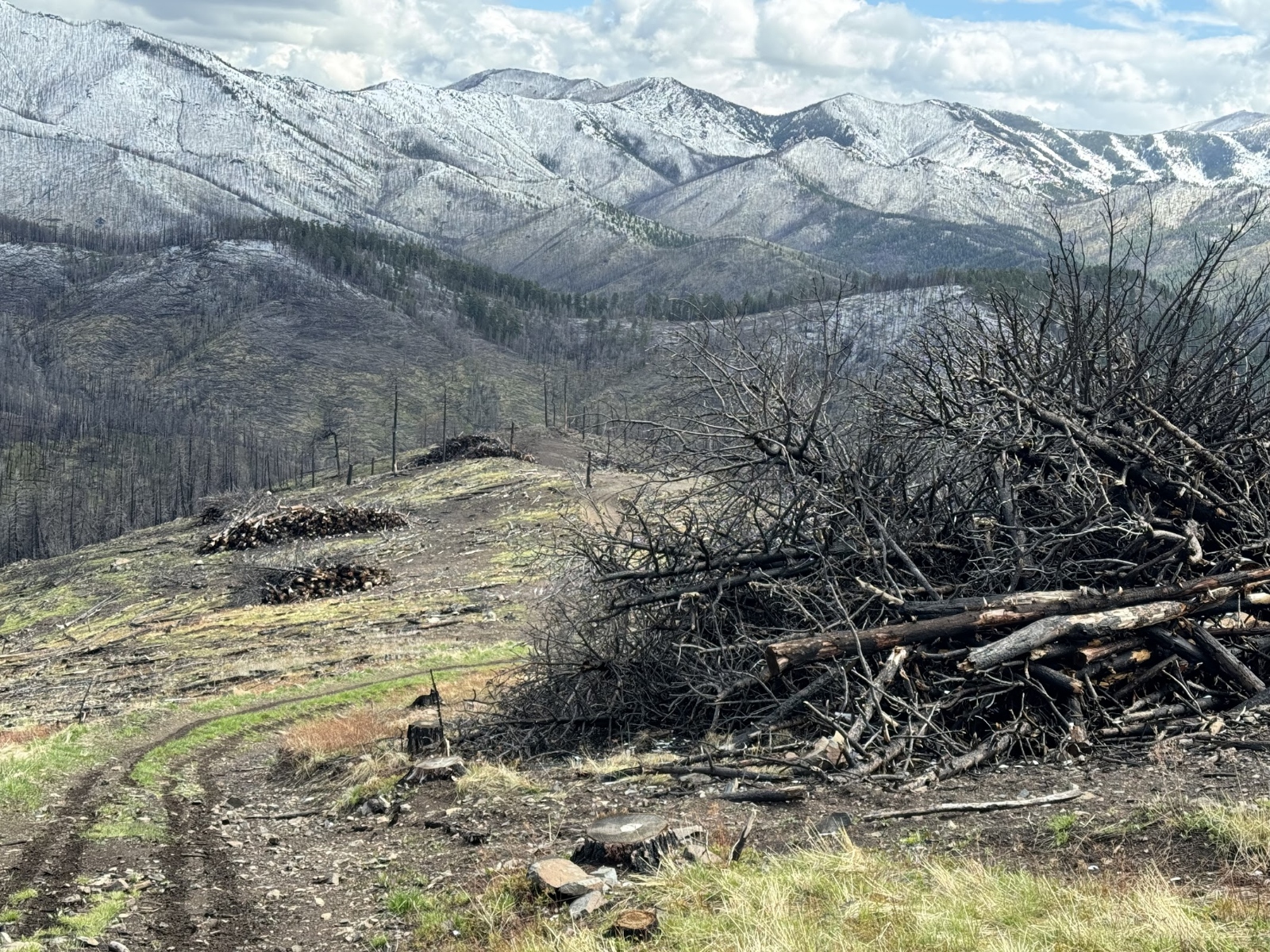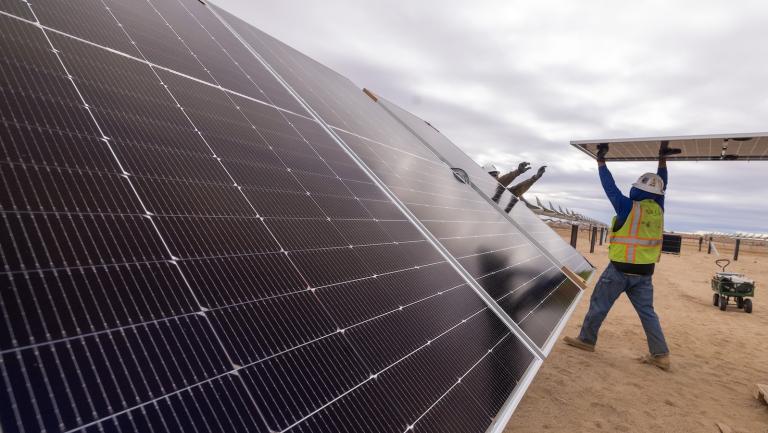In northwestern Montana’s Swan Valley, a pile of about 100 small logs, 10 feet long or so, sits neatly stacked, ringed by berry bushes, a few white wildflowers, and towering larch trees. Surrounding the logs are several acres of U.S. Forest Service land, which was thinned of dead, downed, and dense understory trees last year to reduce wildfire risk. The log pile that remains is too small to be processed into lumber, plus the sawmill just down the highway recently closed. So the wood may get sent to a pulp mill, if the price is right. Or it may sit in the forest for years. Smaller limbs may be burned in a prescribed fire. But Ning Zeng, a climate scientist at the University of Maryland, is sizing up the pile, too. He sees another solution: burying the logs, and all the planet-heating gases they’d otherwise release, underground.
That’s the idea of a carbon sequestration technique called wood vaulting. Forests throughout much of the western U.S. are overgrown, full of tangled trees and brush that’s primed to burn. The Forest Service’s wildfire crisis strategy calls for removing excess vegetation on up to 50 million more acres of federal, state, tribal, and private lands by 2032. Scientists and climate tech companies alike say wood vaulting could help store some of the carbon dioxide equivalent, in the form of flammable vegetation, that the Forest Service must deal with in the coming years — an estimated 2.2 billion metric tons. That’s roughly as much CO2 as cement production worldwide emitted in 2016, and as much as forests globally removed from the atmosphere last year.
“There’s more wood in the forest than markets for it to go,” said research forester Nate Anderson, who studies product supply chains for the Forest Service’s Rocky Mountain Research Station in Missoula. Valuing the carbon stored in wood vaults could change that.

If done properly, burying the debris could help limit the release of greenhouse gases that warm the atmosphere and contribute to climate change. “I don’t see any reason why it can’t be actually quite significant and reach millions of tons of carbon dioxide sequestered per year, in the U.S. alone,” said Sinéad Crotty, the director of the nonprofit Carbon Containment Lab. Daniel Sanchez, a professor who studies CO2 removal at the University of California, Berkeley, agrees. “Wood vaulting is a newly emerging approach that we think is relatively low-cost and relatively scalable,” he said.
Investors, including Bill Gates, have poured millions of dollars into jumpstarting wood vaults in recent years. A handful of small-scale sites are in progress across the country, including in Maryland, Nevada, Texas, and Colorado. The Department of Energy recently awarded $50,000 for two companies, including Zeng’s Carbon Lockdown Project, to construct a wood vault in Montana — one of many carbon dioxide removal, or CDR, pilot projects to receive funding. According to the 2023 Intergovernmental Panel on Climate Change’s Synthesis Report, CDR technology — which can include direct air capture technology, land-based carbon sinks, and more — is an “unavoidable” component of limiting warming to 1.5 or even 2 degrees Celsius, which experts say is necessary if we are to avoid irreversible effects of climate change.
Wood vaulting is conceptually simple: Dig a hole with an excavator and bury small trees, woody debris, and other plant materials that aren’t large or valuable enough to sell. The vaults resemble a layer cake of trees, gaps filled with dirt, and more trees stacked on top, finished off with a frosting of topsoil.
Once companies acquire biomass, not just any hole will do. The intrusion of water, oxygen, and even termites could compromise a vault’s durability by encouraging decomposition. Digging vaults in clay or silty soil, away from groundwater, is thought to be best practice. (Some alternative methods actually submerge the wood in water entirely, but that’s less common.) Conditions inside the vault must remain stable — ideally in perpetuity, without human intervention — for projects to uphold their promises. The same kinds of sensors already used in landfills can be installed to monitor data like oxygen, moisture, and methane levels over time.
Digging holes 15 to 25-plus feet deep can mean disturbing soil, destroying habitat, or removing nutrients from the landscape — all potential downsides of wood vaulting — so companies are considering using already-degraded locations, like old industrial sites or mines. (Several also have plans to rehab wood vault sites after trees are buried, planting the soil with native seeds for pollinator habitat or grazing use.) The ideal location for a wood vault is near the source of its biomass, which cuts back on transportation emissions and logistics. Enough labor to transport biomass and construct vaults, plus some sort of protection that they won’t just get dug up in a few decades, are other key factors.
Another concern with wood vaulting is that it may incentivize more logging than necessary. But so far, the industry is focused on burying the leftovers of wildfire risk reduction treatments, as well as trees that have already burned or were hazard trees removed from urban environments. Guidelines from Stripe Inc.’s Frontier fund, one of the leading funds that purchases carbon dioxide removal credits from startups, recommends the leftovers of wildfire risk reduction projects as a sustainable source.
The science to know how long these vaults could keep CO2 out of the atmosphere is still in the works. “We want to be as clear-minded as possible when promising anything around durability,” Crotty said. If done properly, Sanchez thinks vaults might be able to store CO2 for hundreds to thousands of years; companies share numbers that range from 100-plus to 1,000-plus years.
While it’s hard to say exactly how long wood vaults may be able to store carbon, previous discoveries hold clues. A bulldozer on Carbon Lockdown Project’s Canada site found a red cedar log buried deep in the soil; Zeng still has it in his office today. He says further analysis (yet to be published in a peer-reviewed journal) confirmed it was 3,000 years old but had only lost 5 percent of its carbon.
Another way to analyze wood vaulting’s potential is by comparing how much carbon it can store to other more established techniques. Wood vaulting’s carbon yield is high compared to that of biochar, a charcoal-esque soil amendment that comes from partially combusted organic material. Biochar can retain about 30 percent of its biomass’ original carbon, while wood vaulting is thought to store over 90 percent, according to Sanchez.
Wood vaulting is also fairly cheap compared to other methods. Calculations from one of Zeng’s test sites found it cost $105 per metric ton of CO2, mostly in transportation costs. For comparison, the average cost of biochar in California is $400 per metric ton of CO2, and direct carbon capture technologies can cost anywhere between $600 to $1,000 per metric ton of CO2. “That’s the transformative aspect of this idea compared to many other biomass utilization strategies,” Zeng said. “It is going to come down to economics.”
Several companies are currently trying out wood vaulting, mostly on private land. Zeng created the Carbon Lockdown Project, which began with a research site outside Montreal, in 2013. He’s now working on a property in Maryland for trees removed from urban settings that would have otherwise been mulched.
Then there’s Mast Reforestation, a company that seeks to replant forests after they burn for carbon credits. CEO Grant Canary said he’s especially interested in burying the already-burned trees that create a hazard for workers and the tiny saplings they plant. The company plans to store between 5,000 and 20,000 metric tons of CO2 equivalent that come from trees on hundreds of acres of recently burned private land in central Montana. Mast Reforestation is partnering with Zeng’s Carbon Lockdown Project on the site, and Canary said construction may be underway as soon as the end of 2024 or early 2025. As a winner of the Department of Energy’s prize, the project promises over 17,000 carbon dioxide removal credits to the federal government by the end of 2028.

Also out West, Kodama Systems is in the permitting phase for a wood vault to store about 1,000 metric tons of CO2 equivalent in western Nevada. Material could be in the ground as soon as later this year. Arid rangelands in this area are considered prime for wood vaults; researchers at the Carbon Containment Lab also say the Four Corners region of Arizona, New Mexico, Colorado, and Utah has high potential for wood vault development. Carbon Containment Lab scientists partner with companies, including Kodama Systems, to collect their own independent data.
So what’s needed to turn wood vault projects from the handful of pilot sites that currently exist to a carbon dioxide removal technology at scale? More science to verify longevity and storage claims, more money to jumpstart additional projects, and more buyers of carbon dioxide removal credits. While companies and scientists have their sights set on working with the Forest Service someday, government land management agencies are notoriously slow to try something new, meaning a public-private partnership on wood vaults is still far off.
For Zeng, standing in the middle of the woods, seeing everything from mill infrastructure to potential wood vaulting sites in Colorado, Montana, and beyond was illuminating, fusing theory with practice on the ground. “I got really encouraged on this trip,” he said. “The dots are getting connected.” While wood vaulting is not a single-handed solution for overgrown forests, wildfire risk, and a rapidly warming climate, it may be a simple solution to sequester some carbon and reduce wildfire risk, too.





